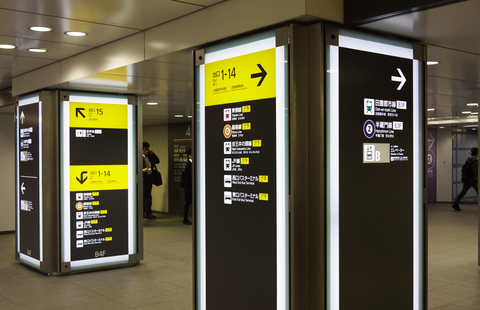If you’ve ever been to Tokyo, you’ll no doubt be familiar with the map of the city’s rapid transit system, the TokyoMetro (東京メトロ). At first, this colourful and highly intricate web of interconnecting lines can seem somewhat daunting, but it shouldn’t take too long to get used to.

Most of the names of its many stations (駅, えき) and lines (線, せん) are derived from historical districts of what is now known as Tokyo, and some of these can serve as useful examples of important Japanese language concepts. In addition, some of them are just downright cool. For example, the name of the station of perhaps the most well-known district of Tokyo outside of Japan, Akihabara (秋葉原), translates to the decidedly poetic Field of Autumn Leaves. Here are a few more.
English: Freedom Hill – 自由が丘 (じゆうがおか)
This is a classic example of the historical usage of the particle が. What we have here is in fact not the usual ‘subject marker’ が; in classical Japanese, が had a similar function to the particle の in use today. So what we have here, written another way, is in fact 自由の丘 – “Hill of Freedom”, or “Freedom Hill”. This historical usage of が can also be seen in the title of Japan’s national anthem – 君が代 (きみがよ).
English: Mist’s Gateway – 霞ヶ関 (かすみがせき)
In the middle of this station name is a small version of the katakana character ケ. This ‘small ke’ is in fact of different origin to its larger version, and is thought to be a simplification of the kanji 箇.
It’s used when counting months (三ヶ月, three months) and countries (三ヶ国, three countries) among other things, and in such instances, is pronounced か. Curiously, it can also be found in place names, where it is pronounced が. When used in this second way, it fulfils the same role as the が discussed above. Aokigahara – 青木ヶ原 (あおきがはら), a forest near Mt. Fuji, which is the world’s second most popular suicide location.
English: New Bridge – 新橋 (しんばし)
On the Tokyo Metro map, 新橋 is officially romanised as Shimbashi. However, nowadays we would be more likely to write it as Shinbashi. This is because there have existed multiple schemes for romanisation of Japanese (writing the Japanese language using the Roman alphabet), throughout history. The most well-known of these is Hepburn romanisation, which in its earliest version would render the ん in this station’s name as an m, due to it being before a ‘b’ sound. Later revisions of the Hepburn scheme render ん as n, regardless of where in a word it comes.
While Hepburn romanisation is the most widely used romanisation scheme outside of Japan, Japanese schoolchildren are in fact taught a different scheme, known as Kunren-shiki (訓練式). This is the reason why you might see a Japanese person romanise しょ as syo, rather than sho, for example.
English: Six Trees – 六本木 (ろっぽんぎ)
This infamous district’s station name serves as a good example of a Japanese counter word in action. Here, 本 is the counter for long, thin objects. Before it, we have how many objects we’re counting (六, six) and after it, what we’re counting (木, tree). Six – long, thin objects – tree. Six Trees.
English: Hands of the Mountain – 山手 (やまのて)
If 山 is やま and 手 is て, where does the の come from? There exists a convention whereby in writing, the の in names such as this is dropped, leaving only the kanji remaining. When spoken however, the の is always included. See also: the common Japanese surnames 井上 (いのうえ) and 木下 (きのした).
So, the next time you find yourself on a train in Japan, try working out what the names of the stations you pass through mean in English. There are some intriguing ones out there – 洗足 (せんぞく, Feet Washing), 池袋 (いけぶくろ, Lake Sack), and 御茶ノ水 (おちゃのみず, Tea Water) to name just three.